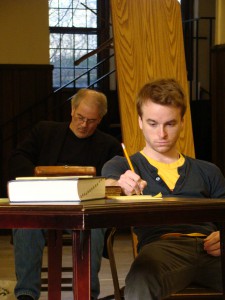 Week 3 down and you know what that means! Yup, time to move to Tudor Court. Everyone’s pretty excited. We had our final run Sunday night for designers, technicians and staff members to get a look at how the show is functioning and moving before we head into the space. Most of the set is up, and I have to say, it’s looking pretty neat.
Week 3 down and you know what that means! Yup, time to move to Tudor Court. Everyone’s pretty excited. We had our final run Sunday night for designers, technicians and staff members to get a look at how the show is functioning and moving before we head into the space. Most of the set is up, and I have to say, it’s looking pretty neat.
Each of the ten scenes in the play take place in a different location, so we do a lot of moving from place to place and we shift around quite a bit in between each scene (also know as the “transition,” a word director Bill Brown doesn’t like to use). I’ve never really asked him why, but I think it’s because transition connotes that it’s not a part of the play, but the space in between the scenes of the play. This is not the case at all. The space, the time in between scenes is an imperative part of the production and the whole feel of the play. We don’t just take blackouts and go from scene to scene in the dark. We could, I suppose, but it doesn’t feel right for this story. This part of the play needs to fit into the whole production and be a sort of connective tissue.
At the Literary Luncheon this week, playwright Brett Neveu mentioned he originally conceived of the play as “ten ten-minute scenes.” And they somehow need to be linked. Transportation is a big part of the piece. Several scenes take place at bus stops and at train stations as Eddie and Sam journey from here to there. The design of the set gives a general feel for the whole play, but fluidly adds and subtracts certain pieces for each specific scene, as well. And the actors do the work to move these set pieces. It evokes the feel of transportation—public transportation. Check out next week’s blog for more info on how all this is going.
Our last week in the space was a great time. By the third week, you really inhabit your rehearsal space and feel pretty darn comfortable there. Everyone has their chair, and the actors have their places where they wait and prepare when off-stage. There’s even a children’s playroom in the church basement, which we use for line work and dialect coaching with Eva Breneman (Mr. Brown refers to this room as the “lido deck”). And the rehearsal table is covered in legal pads, pens and cough drops. The coffee table has little snacks company members have brought in to share. It really is our home, our safe place to play and discover.
We certainly did a lot of discovering this week, diving even deeper into the play and stringing it all together. We also spent more time simply working on lines. The language is tough. It is intentionally disjointed and stilted. Characters struggle for clarity and respond to things brought up pages earlier. Balancing all this and, most importantly, making sense of it has been a huge focus for us. So learning the words exactly (phonetically even) has been a huge help; we created a map and now we have to choose our path. We also spent a lot of time “stacking up the blocks,” as Bill says. Though the play is a series of ten scenes, they lead directly into one another and carry over emotions and desires into subsequent scenes. Seeing how this day, this journey, looks and feels from start to finish has been really important to our work this week—and it will continue to be. Actors experiment with bringing the end of one scene to the top of the next to see if it fuels them differently, drives them someplace new. Creating this through-line is necessary and gives the total play a whole shape.
Check back next week for updates and news about incorporating design!
Josh


No comments yet.